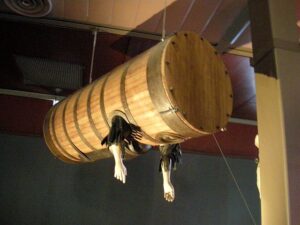 Whenever a ship sinks, it takes with it a lot of gear, personal effects, and sometimes treasures. These days, they send in the submarines, or rather the mini submarines to salvage whatever they can, find out what caused the sinking, and sometimes to aid in raising the ship to the surface. In times past, when a ship went down, it could easily be lost forever, or at least until more modern times when they could finally find it again.
Whenever a ship sinks, it takes with it a lot of gear, personal effects, and sometimes treasures. These days, they send in the submarines, or rather the mini submarines to salvage whatever they can, find out what caused the sinking, and sometimes to aid in raising the ship to the surface. In times past, when a ship went down, it could easily be lost forever, or at least until more modern times when they could finally find it again.
When the Vasa, an amazingly beautiful Swedish warship that sank on its maiden voyage, 1400 yards into its voyage sat in the harbor for years. The did manage to get the cannon from it right away, but everything else sat underwater until the 1950s, when they had a better way to salvage it. When the world’s first completely covered underwater diving suit was invented around 1715, it consisted of an airtight oak barrel. The suit was used mainly for salvage operations of shipwrecks. I wonder what they could have done with Vasa using that. Vasa wasn’t in dangerously deep water, and could have been accessed easily today, but they just didn’t have the equipment.
The cross between a diving bell and standard diving dress is rather interesting. I wonder if the barrel design John Lethbridge used in 1715 was seriously difficult to move in. It reminds me a of a comical space suit, but I guess it served its purpose. However odd it is, it was the first underwater diving suit, and it is currently located in the Cité de la Mer, a maritime museum in Cherbourg, France.
Lethbridge came up with the idea for his diving suit while working for the East India Company as a salvager. The barrel was airtight, so the diver was protected and safe. The barrel was six feet in length, and the diver had little control of it once it was lowered into the water. The diver had to lay flat on his stomach once the barrel. The barrel had two airtight holes on the sides for the diver’s hands and a hole with glass in the front for use as the diver’s viewing window. During trials, Lethbridge demonstrated that the suit enabled divers to stay 12 fathoms (a unit of length equal to six feet) underwater for at least 30 minutes at a time. That was hard for  me to figure out, until I read that once the diver comes out of the water after 30 minutes, the crew pumped fresh air into the suit through a vent using bellows. At the same time, the used air was let out through another vent. Then, with the fact that the barrel was airtight, the diver was good for another 30 minutes. It wasn’t perfect, but it was much further along than salvage operations had been before it. The suit, while odd and very primitive was an immediate success. It was used mostly to retrieve material from shipwrecks. During Lethbridge’s first salvage…the maiden voyage of the diving suit, as it were, Lethbridge recovered 25 chests of silver and 65 cannons! I would call that a definite success.
me to figure out, until I read that once the diver comes out of the water after 30 minutes, the crew pumped fresh air into the suit through a vent using bellows. At the same time, the used air was let out through another vent. Then, with the fact that the barrel was airtight, the diver was good for another 30 minutes. It wasn’t perfect, but it was much further along than salvage operations had been before it. The suit, while odd and very primitive was an immediate success. It was used mostly to retrieve material from shipwrecks. During Lethbridge’s first salvage…the maiden voyage of the diving suit, as it were, Lethbridge recovered 25 chests of silver and 65 cannons! I would call that a definite success.


Leave a Reply